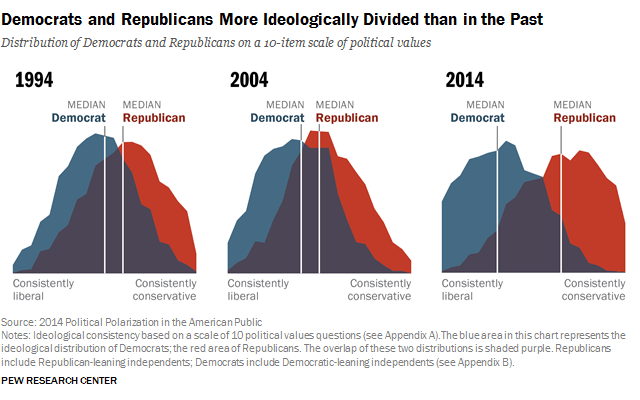Finding common ground begins with understanding the moral foundations that motivate other people.

"Things fall apart; the centre cannot hold." –W. B. Yeats
The poet W. B. Yeats was describing the aftermath of World War I, but he might as well have been discussing the political climate today, almost a century later. As the below graphic from the Pew Research Center shows, Americans are far more partisan than they were just two decades ago, and they now tend to regard members of the opposing political party with distrust and animosity.

Twenty years ago, there was a significant overlap between the views of liberals and conservatives, but now a widening chasm has taken its place. This makes it harder than ever to find common ground when we discuss important issues with our friends and colleagues. It also creates a difficult situation for CEOs and other senior leaders. They know their followers want them to take a stand on important social issues. But can they really speak up about what matters without alienating some of their customers, employees, and investors?
The Moral Empathy Gap: Why We Fail to Find Common Ground
Researchers Matthew Feinberg and Robb Willer hypothesize that one reason we fail to find common ground when interacting with others is that we have a moral empathy gap. By "moral empathy gap" they mean that we fail to properly understand what underlies others' moral convictions because we focus too exclusively on our own reasons, convictions, and values.
Feinberg and Willer ground their hypothesis in Moral Foundations Theory (MFT). MFT proposes that there are five primary areas of concern—five moral foundations—that form the basis of our moral judgments. They are:
Care - The need to prevent or alleviate suffering.
Fairness - The need to seek equality and prevent discrimination.
Loyalty - The need to show allegiance to one’s own group.
Authority - The need to respect superiors and tradition.
Sanctity - The need to maintain sacredness and purity.
Researchers have discovered that when a serious disagreement arises between two people or groups, it is often because they do not endorse the same moral foundations, or they prioritize them differently. Liberals, for example, tend to endorse the care and fairness foundations more than conservatives. And conservatives tend to endorse the loyalty, authority, and sanctity foundations more strongly than liberals.
The moral empathy gap arises when we forget to take the other person's perspective and think about the moral foundations that motivate him or her.
Feinberg and Willer recruited liberals and conservations, and asked them to try to persuade each other. They asked liberals to write a essay in support of a "liberal" issue, one that most liberals support (in this case, the issue was same-sex marriage), but in a way that would convince a conservative to support the issue as well. What happened? Most liberals appealed only to their own moral foundations, not those that mattered most to conservatives. Conservative participants were asked to convince liberals to support a more conservative issue (in this case, making English the official language of the U.S.). The conservatives also appealed almost exclusively to the moral foundations they endorse, not those that liberals endorse.
Moral Reframing: The Art of Seeing Another’s Moral Point of View
Feinberg and Willer introduce a technique they call "moral reframing" that they say can help us bridge the empathy gap. The technique involves presenting an issue in such a way that it appeals to the moral foundation of the receiver or audience, rather than the moral foundation of the messenger.
What might this look like? Imagine you're reading a magazine, and you come across ad from an environmental organization asking for donations. It says:
Save the environment! Protect it from harm—for our sake and for others' sake; it's only fair.
This ad would likely appeal to liberals, who prioritize the care and fairness moral foundations. But it may not connect with conservatives. Instead, what if the ad appealed to the moral foundation of sanctity? For example:
Maintain the purity of the natural world! We have a sacred duty to preserve its cleanliness and serenity.
The second ad is more likely to spark the interest of conservative readers, helping them suddenly see that environmentalism may align with the values they already hold dear.
Unfortunately, such moral framing is rare. Feinberg and Willer analyzed more than 400 major newspaper op-eds on environmentalism along with more than 50 of the most popular YouTube videos on environmentalism, and they found that, like the first example above, the content of these articles and videos tended to appeal to the care and fairness foundations while ignoring the loyalty, authority, and sanctity foundations. So no matter how high quality, engaging, or well-reasoned this content may be, it is not positioned well to win over new supporters for the cause of environmentalism.
How to Bridge the Moral Empathy Gap
Each leader faces tough decisions about how to speak about important issues to stakeholders with a wide variety of moral concerns. Here's how moral reframing can help bridge the moral empathy gap and help you connect with diverse audiences.
Listen closely to learn others’ favored moral foundations. Listen to the language others use when they speak about moral issues. When you hear a colleague express concern, which foundation lies at its root? Is there a way you can "speak their language" about an issue you find important?
Understand your moral foundations—and how they might get in the way. Often a person with strongly held beliefs and values finds it difficult to recognize that not everyone shares his or her convictions. But the most effective ethical leaders recognize that cooperation is possible, even with people whose core convictions differ from their own. Their goal is to build a diverse coalition around a common cause, not lead a cult of like-minded people.
Believe in the prospect of finding common ground. Moral foundations theory helps us recognize the sources of our most profound disagreements. But it reveals many things we have in common. Most people understand all five foundations—most of our differences lie in the fact that we simply prioritize some over others. We can learn to respect one another by recognizing that even people who disagree about core issues still likely have some moral concerns in common.
Our divided world will not be healed over night. But by recognizing and working to close the moral empathy gap, you take a small step toward making trust and cooperation a hallmark of your leadership and your organization.
Further Reading
Feinberg, M., & Willer, R. (2013). The moral roots of environmental attitudes. Psychological Science, 24(1), 56-62.
Feinberg, M., & Willer, R. (2015). From gulf to bridge: when do moral arguments facilitate political influence?. Personality and Social Psychology Bulletin, 41(12), 1665-1681.



